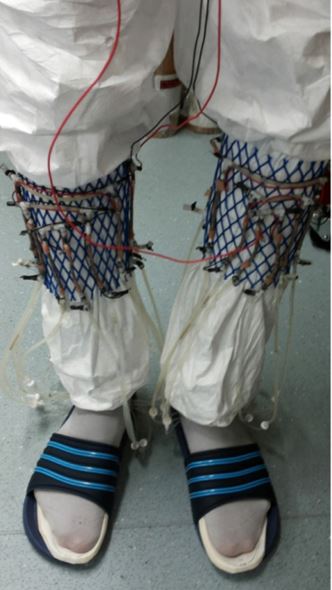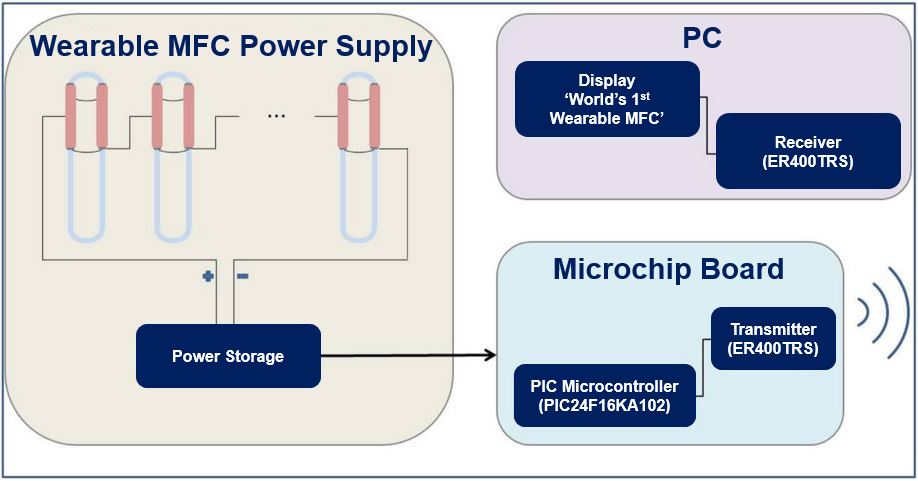A pair of socks fueled by urine pumped by the wearer’s footsteps has powered a transmitter to send a Wi-Fi signal to a PC. The socks are embedded with miniaturised MFCs (microbial fuel cells) that are fuelled with urine.
Scientists at the Bristol BioEnergy Centre, part of the University of the West of England (UWE Bristol), and colleagues at the Istituto Italiano di Tecnologia in Italy, wrote about their breakthrough in the academic journal Bioinspiration and Biomimetrics.
The authors say theirs is the first self-sufficient system powered by a wearable energy generator based on microbial fuel technology.
 A schematic drawing of the manual pumping system designed and developed to circulate the urine through the MFCs. (Image: iopscience.iop.org)
A schematic drawing of the manual pumping system designed and developed to circulate the urine through the MFCs. (Image: iopscience.iop.org)
Professor Ioannis Ieropoulos,who led the lab-based experiment, and colleagues explained how soft MFC’s were embedded within a pair of socks and supplied with fresh urine that circulated as the human operator walked.
No mains electricity required to circulate the urine
Before this experiment, continuous-flow MFCs would rely on a pump connected to the mains to circulate the urine over the microbial fuel cells. In this experiment, however, they relied entirely on human activity.
The manual pump, which was based on the action of walking and a simple fish circulatory system, caused the urine to pass over the MFCs, thus creating energy.
Continuous fluid push-pull is attained by placing soft tubes under the heels, plus the walking activity of the wearer.
This wearable MFC system successfully ran a wireless transmission board that managed to send a message via Wi-Fi every two minutes to the PC-controlled receiver module.
System is entirely self-sufficient
Prof. Ieropoulos said:
“Having already powered a mobile phone with MFCs using urine as fuel, we wanted to see if we could replicate this success in wearable technology. We also wanted the system to be entirely self-sufficient, running only on human power – using urine as fuel and the action of the foot as the pump.”
 An image of the developed wearable system worn by a human. (Image: iopscience.iop.org)
An image of the developed wearable system worn by a human. (Image: iopscience.iop.org)
“This work opens up possibilities of using waste for powering portable and wearable electronics. For example, recent research shows it should be possible to develop a system based on wearable MFC technology to transmit a person’s coordinates in an emergency situation.”
“At the same time this would indicate proof of life since the device will only work if the operator’s urine fuels the MFCs.”
MFCs use bacteria to produce electricity from waste fluids. They draw on the biochemical energy used for microbial growth and convert it directly into electric power.
According to the researchers, this technology can use any type of organic waste and turn it into useful electric power without relying on fossil fuels, i.e. it is an extremely valuable green technology.
 Block diagrams of the wearable MFC power supply and electronic setup. (Image: iopscience.iop.org)
Block diagrams of the wearable MFC power supply and electronic setup. (Image: iopscience.iop.org)
The Bristol BioEnergy Centre recently launched a prototype urinal together with Oxfam that uses pee-power (or wee-power) technology to light cubicles in refugee camps.
In an Abstract in the journal, the authors wrote:
“A wireless programmable communication module, engineered to operate within the range of the generated electricity, was employed, which opens a new avenue for research in the utilisation of waste products for powering portable as well as wearable electronics.”
Citation: “Self sufficient wireless transmitter powered by foot-pumped urine operating wearable MFC,” M Taghavi, A Stinchcombe, J Greenman, V Mattoli, L Beccai, B Mazzolai, C Melhuish and I A Ieropoulos. Bioinspiration & Biomimetics. 10 December, 2015. DOI:10.1088/1748-3190/11/1/016001.

